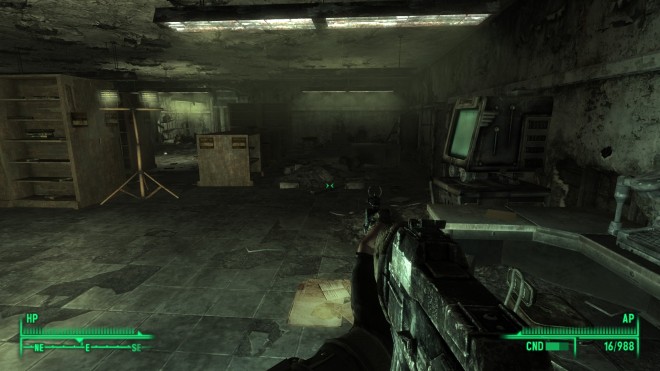Video games can be a controversial topic; they are frequently condemned for their violence and accused of corrupting vulnerable young people. However as the variety and scope of games continue to expand, and online gamers create ever more complicated virtual communities, it becomes increasingly difficult to ignore or dismiss them. Computer games have become for focus of a lot of scholarly research, and there is even an entire journal dedicated to the topic, called Game Studies. I dabble in gaming myself, and of course my attention has been drawn to the variety of ways in which archives are represented in the myriad of virtual worlds brought to life through my computer screen.
One of my personal favourites, Fallout 3, is also the game which has one of the most realistic representations of an archive in gaming, in some respects anyway. Fallout 3 is a first person shooter/RPG (Role-Playing Game, for the uninitiated), set in a post apocalyptic world where civilisation has been destroyed by nuclear war. The action takes place in and around Washington D.C. in the year 2277, and many of the locations are based on real places, including the National Archives. Now obviously the building is looking a little the worse for wear after 250 years and a nuclear apocalypse, but it is much the same in the game as it is in real life, right down to those awkward microfiche machines that have dogged many an archival researcher. The player can embark on a quest to retrieve a copy of the Declaration of Independence from the archive’s basement, copies of which are held in the real National Archives.


Not all games are set in our world, however. Path of Exile and Diablo 3 are medieval dark fantasy action RPGs, set in worlds full of magic, swords and necromancy. They are both played in the axonometric projection, which is a posh way of saying that the player looks down on the action. And they also both have archives, although they are not ones that a modern day archival researcher would necessarily recognise. They are arguably more similar to the archives of the popular imagination, full of dark corners and scrolls. In Path of Exile, the player has to fight their way through hordes of zombie skeletons called ‘Undying Archivists’ to reach their objective, the Golden Pages. In Diablo 3, the archives are the domain of Zultan Kulle, an evil warlock who collected his archive as part of his unceasing quest for more power. In both cases, they are evil places, full of enemies and danger.



Dark Souls is another medieval dark fantasy action RPG, but it is played in the third person (the camera is behind the player, not above). Widely acknowledged as one of the hardest games of recent years, it has also been incredibly popular. And it also has an archive, also collected by a villain, and also not a particularly nice place to be. In this case the baddie is Seath the Scaleless, a giant dragon who betrayed his own kind and now hides out in his archives, desperately searching for the key to immortality because he has no scales to protect him.


Archives also crop up in science fiction games. Destiny is a first person shooter set in a far-off future where the player is a guardian of the last safe city on earth. The player explores the ruins of human civilisation spread throughout the universe, but even in this era there are archives. In one quest, the player is sent to Venus to prevent the accumulated knowledge of the Golden Age being obtained by the Fallen, one of civilisation’s many enemies. In this case the archives are the domain of the goodies, not the bad guys, but it is still a risk, capable of doing great damage if it falls into the wrong hands. Knowledge, in many of these games, is dangerous.
The world of video games is vast, and games come in a huge range of shapes and sizes. Archives do seem to crop up relatively often though, and I’m sure I’ve only shown you a fraction of the examples here (please do let me know if the comments about games I’ve missed!) Perhaps it is just the nature of video games, but archives are frequently the domain of villains, bad people intent on getting what they want, whether it’s more power or more life. This bears little resemblance to real-life archives, which makes me wonder why this image appears so often. Where does it come from, and what impact does it have on popular understandings of the archive?
Special thanks for this post go to Daniel Dougherty, who provided some of the images, most of the information, and who introduced me to video games in the first place.
Sources and Further Reading
Anon. “National Archives and Records Association.” Wikipedia. Last modified 25th May 2015, accessed 4th June 2015. http://en.wikipedia.org/wiki/National_Archives_and_Records_Administration
Anon. “The National Archives.” Fallout Wiki. No date, accessed 4th June 2015. http://fallout.wikia.com/wiki/National_Archives
Davies, Martin. “Gamers Don’t Want Any More Grief.” The Guardian. Last modified 15th June 2006, accessed 4th June 2015. http://www.theguardian.com/technology/2006/jun/15/games.guardianweeklytechnologysection2
Stuart, Keith. “The Cliche of the Lone Male Gamer Needs to be Destroyed.” The Guardian. Last modified 11th May 2015, accessed 12th May 2015. http://www.theguardian.com/technology/2015/may/11/the-cliche-of-lone-male-gamer-needs-to-be-destroyed
